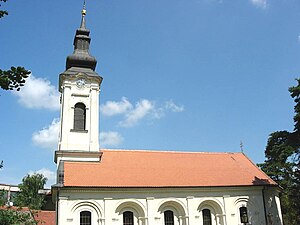Törökkanizsa
|
Novi Kneževac Нови Кнежевац Törökkanizsa |
||
|---|---|---|
| Town and municipality | ||

The Orthodox church
|
||
|
||
 Location of Novi Kneževac within Serbia |
||
| Coordinates: 46°03′N 20°06′E / 46.050°N 20.100°ECoordinates: 46°03′N 20°06′E / 46.050°N 20.100°E | ||
| Country |
|
|
| Province | Vojvodina | |
| District | North Banat | |
| Government | ||
| • Mayor | Dragan Babić (DS) | |
| Area | ||
| • Novi Kneževac | 305.0 km2 (117.76 sq mi) | |
| Elevation | 84 m (276 ft) | |
| Population (2011) | ||
| • Novi Kneževac | 6,960 | |
| • Metro | 11,269 | |
| Time zone | CET (UTC+1) | |
| • Summer (DST) | CEST (UTC+2) | |
| Postal code | 23330 | |
| Area code(s) | +381(0)230 | |
| Car plates | KI | |
| Website | www.noviknezevac.rs; www.noviknezevac.info | |
Novi Kneževac (Serbian Cyrillic: Нови Кнежевац [nɔ̂ʋiː knɛ̌ːʒɛʋats], Hungarian: Törökkanizsa) is a town and municipality located in the North Banat District of the autonomous province of Vojvodina, Serbia. The town has a population of 6,960, while the Novi Kneževac municipality has 11,269 inhabitants (2011 census).
The Serbian name of the town originates in the Serbian word "knez" ("prince" in English), and the full meaning of the name is "the prince's new place" in English.
The city's name in various languages include Serbian: Novi Kneževac or Нови Кнежевац, Hungarian: Törökkanizsa ([ˈtørøkkɒniʒɒ]), Romanian: Noul Cnezat, Croatian: Novi Kneževac, and German: Neu-Kanischa.
The older Serbian names used for the town were Turska Kanjiža (Турска Кањижа), Mala Kanjiža (Мала Кањижа) and Nova Kanjiža (Нова Кањижа).
The Serbian and Hungarian languages are officially used by the municipal authorities.
People inhabited this area as early as the Neolithic era as well. Historically, the region was populated by Sarmatians, Gepids, Huns, Avars and Slavs. The first written record of Novi Kneževac was made in the 9th century, mentioning under the name "Kneža". In the next century, it was mentioned as "Kanjiša". Until the arrival of the Ottomans, it was under the administration of Hungarian feudal landlords. In the 16th century, during the Ottoman administration, it was populated by Serbs, its name became known as "Turska Kanjiža" and there were already 30-40 houses in the settlement at the beginning of the 18th century
...
Wikipedia

